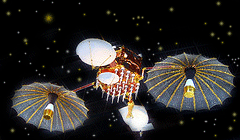The GPS system is a worldwide navigational system operated by the US military. The system is maintained by USNO, the United States Naval Observatory. The Global Positioning System is implemented from space by 24 satellites in high orbit. Each satellite has precise timing equipment that can be used to triangulate position for navigational purposes. Low-cost GPS antennas and receivers are now widely available and provide precise time and frequency information worldwide.
This article presents an introduction to using the GPS system for computer timing applications. It describes the equipment that can be utilised to provide a precise time resource for computers and computer networks.
Each GPS satellite has a highly accurate atomic clock timing reference, which can be used by NTP servers to synchronise computer networks. Each satellite continually broadcasts accurate time and positioning information. This information can be received by a GPS receiver and externally mounted GPS antenna. The timing information received is referenced to UTC time. The system is a free to air service requiring no set-up or subscription fees.
Many Network Time Protocol (NTP) server systems utilise GPS time as an external timing reference to synchronise Windows, LINUX, UNIX and other operating systems and network infrastructures. GPS is an ideal time and frequency source because it can provide highly accurate time anywhere in the world using relatively cheap components.
 Each GPS satellite transmits a very low-power radio signal at two frequencies; L1 and L2. L1 is the civilian frequency band transmitted at 1575 MHz, while L2 is used for military positioning purposes. The radio signal transmitted by each satellite can easily pass through material such as glass and plastics but are blocked more substantial materials used in buildings. The signals travel by line of sight. The ideal location for a GPS antenna is on a rooftop with a good view of the sky.
Each GPS satellite transmits a very low-power radio signal at two frequencies; L1 and L2. L1 is the civilian frequency band transmitted at 1575 MHz, while L2 is used for military positioning purposes. The radio signal transmitted by each satellite can easily pass through material such as glass and plastics but are blocked more substantial materials used in buildings. The signals travel by line of sight. The ideal location for a GPS antenna is on a rooftop with a good view of the sky.
The radio signals can be received by a low-cost GPS antenna. The antenna is essentially a high gain amplifier, which is used to amplify and transmit the weak radio signals down a coax cable to a GPS receiver.
The cable length that can be utilised between a GPS antenna and receiver is critical. The maximum distance that can be utilised is dependant on the gain of the antenna and the quality of the coax cable used. High antenna gain and high quality coax allows for much longer cable runs.
GPS signal amplifiers can be fitted inline on the coax cable to boost the signal and increase cable length. GPS amplifiers are generally powered from the coax cable. The higher the amplification, or gain, provided by the antenna, the longer the cable length that can be utilised.
 Roof-mounted antennas can be prone to lighting strikes or other voltage surges. A lightning strike up to a quarter of a mile away can damage electronic components. Therefore, it is recommended that a surge suppressor be fitted. Lightning or surge suppressors are installed inline on the GPS cable and redirect any surge to earth. Various types of surge suppressor are available, from gas discharge devices to solid-state multi-strike devices.
Roof-mounted antennas can be prone to lighting strikes or other voltage surges. A lightning strike up to a quarter of a mile away can damage electronic components. Therefore, it is recommended that a surge suppressor be fitted. Lightning or surge suppressors are installed inline on the GPS cable and redirect any surge to earth. Various types of surge suppressor are available, from gas discharge devices to solid-state multi-strike devices.
GPS receivers, similar to those found in automobiles, decode the received signal from the antenna and provide easily readable information in a serial format. Most operating systems, including Microsoft Windows, LINUX and UNIX as well as time server systems can utilise the time output provided by the GPS receiver for accurate synchronisation. Many different GPS protocols are utilised, the most popular being NMEA. The NMEA protocol was developed by the National Marine Electronics Association. The protocol specifies a set of sentences that contain time and positioning information obtained by the GPS receiver. The sentences can be parsed by a PC or time server to obtain accurate time.
To summarise, the GPS system is an excellent source of precise time for NTP server systems or for synchronising stand-alone Windows, LINUX and UNIX PC's. By using relatively low-cost components, the Global Positioning System can provide time sensitive applications with precise timing information.
Contributor
David Evans is an experienced technical author in the telecommunications and network time synchronisation industries. You can find out more about GPS NTP Time Server and Windows Time Server systems at: http://www.timetools.co.uk/time-servers/ref/windows-time-server-solutions.htm